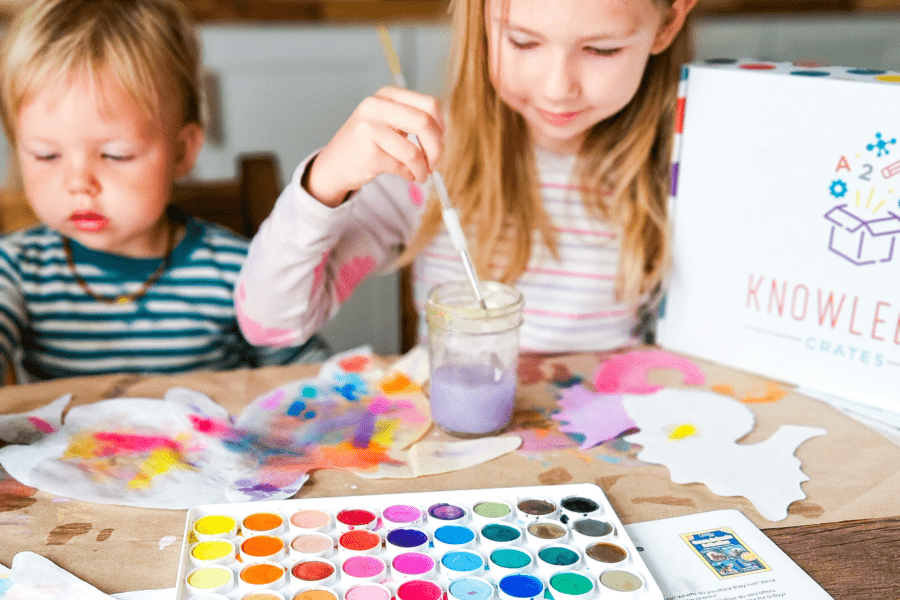
The Best Homeschool Art Curriculum (Isn’t Really a Curriculum at All)
|
|
Let’s be real—when many parents think about teaching art officially as part of their homeschool, they assume it has to look like “art class” from school: formal lessons, lectures about line and form, and a list of skills to be mastered in order. That’s the model a lot of traditional art curriculums still follow. And if you’re the kind of parent who wants a neat, structured program to check off the box, that might sound like the right fit.
But here’s the thing: most homeschoolers don’t actually need a traditional art curriculum to give their kids a strong, joyful foundation in the arts.
In fact, the best homeschool art experiences often come from open-ended exploration, hands-on projects, and giving kids room to create without worrying about “doing it right.”
So before you invest in a stack of art textbooks or feel guilty for not having a formal plan, let’s look at why less structure might be exactly what your homeschool needs when it comes to art—and how to make that approach work for you.
Table of Contents
At its core, an art curriculum should do three things:
Expose kids to a variety of materials and techniques
Help them develop confidence in creative expression
Teach them to observe, reflect, and respond to the world around them
That doesn’t require a daily schedule or a 30-lesson workbook. It requires opportunities to create, space to explore, and a few good tools.
Especially in the early years, art is more about process than product. Kids learn through doing—not by memorizing art terms or copying someone else’s drawing.
Many homeschool art curriculums are built like school programs: lesson one, skill two, final project. And while that can be useful in some seasons, it can also:
Feel rigid or overwhelming
Put pressure on parents who don’t feel “artistic”
Kill creativity by focusing too much on results
If you’ve ever tried to follow a scripted art lesson and watched your child lose interest halfway through, you’re not alone.
Art is supposed to be freeing, not frustrating. And sometimes, following a strict program can actually make it harder to enjoy the creative process.
Instead of asking “Which curriculum should I buy?” try asking:
What kinds of art does my child naturally enjoy?
Do they love painting, sculpting, crafting, building, or doodling?
What materials do we already have at home?
How can I offer regular opportunities to create?
From there, you can build a simple, flexible art experience that supports real growth—without the stress of keeping up with a formal curriculum.
Here’s what matters more than any specific book or program:
Schedule art into your week, even if it’s just once or twice. Let it be a part of your routine, not an afterthought.
You don’t need a studio full of professional tools. A small stash of paints, brushes, glue, paper, scissors, and modeling clay goes a long way.
Let kids try new techniques, make mistakes, and experiment. Resist the urge to direct every step—they’ll learn more by doing.
Choose projects that tie into your homeschool themes or reflect your child’s interests. Make a rainforest diorama, a cave painting replica, or a collage of your state’s landmarks. (That’s what we do in our Knowledge Crates art activities!)
It’s okay to throw in a guided drawing video, art history study, or skill-building activity here and there—just don’t let it push out the open-ended exploration.
Open-ended art might seem “too loose” at first glance, especially if you’re used to traditional subjects like math or language arts.
But here’s what kids learn through this kind of creative process:
Fine motor skills from cutting, drawing, gluing, and painting
Problem-solving by figuring out how to bring an idea to life
Visual literacy by interpreting and using shapes, lines, and color
Confidence from seeing their own ideas take shape
Connection as you and your child enjoy playfully creating side by side
It also builds the foundation for deeper artistic studies later. A child who’s been allowed to explore freely is more likely to enjoy formal lessons when they do start learning techniques and vocabulary.
You don’t have to be!
In fact, one of the best things you can do is create with your child—not as a teacher, but as a fellow learner. Try things. Make mistakes. Laugh at the results. It sends a powerful message: art is for everyone.
If you’re still feeling nervous, here are some low-pressure places to start:
Process art (no end goal—just play with the materials)
Guided drawing videos for kids (lots on YouTube)
Art-based picture books (like Ish by Peter H. Reynolds)
Simple seasonal crafts or nature art
Themed activity kits that include art (like those in Knowledge Crates)
Homeschool parents often share that:
Their kids are more engaged with open-ended art than with structured lessons
Art time becomes a calming, creative break in their day
They’re surprised how much their kids learn from “just playing with art”
It opens the door to deeper conversations about artists, cultures, and expression
And perhaps most importantly: it brings joy back into learning.
You don’t need a formal curriculum to give your child a rich, creative art education. You just need space, materials, time—and permission to let go of perfection.
Because at the end of the day, the best homeschool art curriculum is the one that sparks joy, invites curiosity, and makes room for expression.
And sometimes, that looks a lot less like a “curriculum”… and a lot more like finger paint, glue sticks, and a very proud smile.
Products Featured In This Blog
